The Benefit of Headspace Trap Coupled with GC–MS for the Determination of Trace Levels of BTEX Compounds in Drinking Water
This article will focus on the development of an optimized gas chromatography–mass spectrometry (GC–MS) method that improves upon the current EPA and European detection limit requirements for BTEX compounds and meets all other criteria described in EPA Method 524.2 for the measurement of purgeable organic compounds in water by capillary column GC–MS.
Photo Credit: science photo/Shutterstock.com
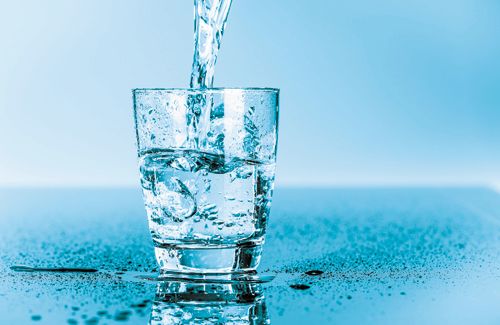
BTEX, a group of structurally similar volatile organic compounds including benzene, toluene, ethyl benzene, and the three xylene isomers are known pollutants, which are typically found near petroleum production and storage sites. BTEX are regulated toxic compounds with benzene an EPA target carcinogen. For that reason, the investigation of these compounds, particularly at trace levels in drinking water, is critically important to ensure the protection of human health. This article will focus on the development of an optimized gas chromatography–mass spectrometry (GC–MS) method that improves upon the current EPA and European detection limit requirements for BTEX compounds and meets all other criteria described in EPA Method 524.2 for the measurement of purgeable organic compounds in water by capillary column GC–MS.
Safe Drinking Water
Two methods are currently used to monitor a suite of volatile organic compounds (VOCs) and hydrocarbon gases in drinking water using gas chromatography (GC). One of these methods is used to measure VOCs using capillary column GC fitted with a purge and trap sample introduction system coupled with mass spectrometry (MS) detection according to EPA Method 524.2 (1). Using this approach, the sample is purged of its volatile components, which are then trapped on a sorbent material, heated, and back-flushed into a GC column, where they are separated and eluted into a mass spectrometer for detection.
The second method involves the determination of volatile hydrocarbon gases, such as methane and ethane, in drinking water. This approach uses headspace coupled with GC and was adapted from EPA RSK-175 for the analysis of dissolved gases in drinking water (2). Headspace is a term used to describe the gas space above the sample in a headspace vial, where the volatile components diffuse into the gas phase and form the headspace gas (3,4). The hydrocarbon gases are efficiently partitioned into the headspace gas volume above the liquid samples, separated, and detected.
Headspace Trap
Static headspace (HS) sampling is ideally suited for extracting volatile compounds. A known amount of sample is placed in a vial and sealed. This vial is then heated in an oven at a method-optimized temperature and for the length of time that equilibration needs to take place.
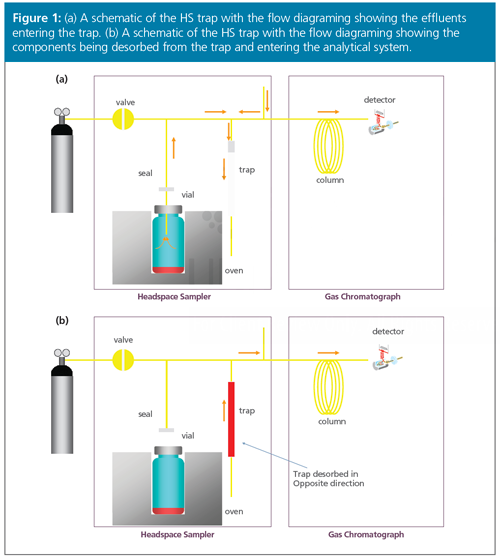
In the analysis of samples with extremely low levels of analytes, an in-line trap is often used in conjunction with a headspace sampling system. The entire headspace vapour is passed through an adsorbent trap to collect and focus the VOCs. The adsorbents are selected to trap the components of interest. The trap is then rapidly heated and the desorbed components are transferred to the GC column. In this way, the amount of compounds entering the GC column can be increased by a factor of up to 100-fold, which is ideally suited for trace levels of organic compounds (5).
Additional advantages of using a trap are that the adsorbents do not retain nitrogen and oxygen and they are hydrophobic. With a short instrument dry purge, the majority of air and moisture is virtually swept from the trap, significantly reducing the amount of these compounds from entering the analytical system as compared to HS without the trap.
This article will therefore focus on the use of headspace and an in-line trap coupled with GC–MS to determine a suite of BTEX compounds (benzene, toluene, ethyl benzene, and m-, p-, o- xylene) in drinking water samples. The goal was to optimize the methodology to surpass the detection limits defined in current US EPA and European directives, as well as meet other data quality objectives such as linearity and precision defined in EPA Method 524.2. Typical accuracy, precision, and method detection limit data generated for BTEX compounds in drinking water using the trapping method and narrow bore capillary column according to this EPA method are shown in Table 1.
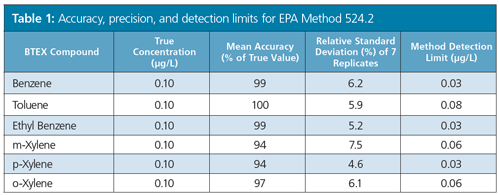
Experimental
A headspace sample handling system, TurboMatrix HS Trap (PerkinElmer Inc.), was used to volatilize and concentrate BTEX compounds in a suite of drinking water samples. To improve detection capability, an in-line trap was employed, which focused the analytes before injection onto the analytical column of a Clarus SQ 8S gas chromatograph mass spectrometertry (GC–MS) system (PerkinElmer Inc.).
Figure 1(a) is a graphical representation of the instrument spiking the trap. The instrument can take several injections of the headspace vapour and continuously focus the compounds on the trap. This specifically enhances sensitivity for targets with high partition coefficients. Only one injection of the headspace volume was used in this experiment because the partition coefficient of BTEX compounds in water at 80 °C is extremely low. Figure 1(b) is a graphical representation of the trap desorbing and effluents swept from the trap into the analytical column.
Headspace Trap Conditions: Sample temperature: 80 °C; needle temperature: 110 °C; transfer line temperature: 120 °C; trap low/trap high: 35 °C to 260 °C; equilibration time: 8 min; dry purge: 2.0 min; trap hold: 2.5 min; outlet dplit: n/a; all HS pressures: 23.3 psi.
GC Separation Conditions: Column: 20 m x 0.18 mm, 1.0-µm Elite 624 (PerkinElmer); oven: 40 °C for 0.5 min, then 35 °C/min to 185 °C; injector (PSS): temperature programmable split/splitless at 180 °C; inlet configuration: HS mode turned on; carrier program (He): 1 mL/min for 0.4 min, then 0.7 mL/min; split flow from GC: n/a.
MS Conditions: Ionization mode: electron impact; acquisition: full scan; mass range: 35 to 350 amu; filament delay: 1.5 min; scan speed: 0.15 s; interscan delay: 0.04 s; run time: 4 min; ion source temperature: 200 °C; transfer line temperature: 200 °C.
Results
Figure 2 shows a sample chromatogram of 4.0 µg/L (ppb) for all five BTEX compounds acquired in full scan mode, while Figure 3 illustrates the water management capability of a HS trap system compared to the 4 ppb BTEX mass scan. In these scans, it can be clearly seen that a 2-min dry purge efficiently removed the water from the trap, whereas a 3-min dry purge reduced water levels to baseline intensity. However, as a faster analytical method was the goal of this study, a shorter dry purge time was implemented.
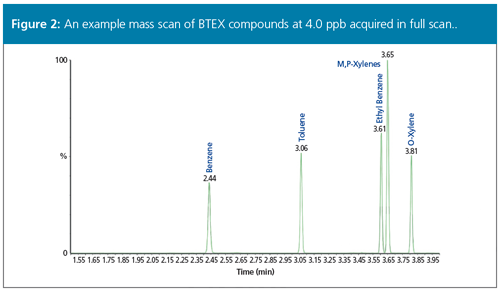
Acquisition was performed in simultaneous full scan and single ion monitoring (SIM) modes. Only the results from the full scan acquisition were used. In addition, the GC–MS system used in this research had a small turbo molecular pump. The reporting limits attained surpassed what was needed; therefore, a smaller turbo molecular pump was chosen because it was more cost effective.
Using this optimized methodology for BTEX compounds, analytical results are displayed in Table 2 and include the correlation coefficient (r2) for a 12-point calibration curve, signal-to-noise for a 0.02 ppb standard, and precision measurements (n = 7) performed at 1.0 ppb.
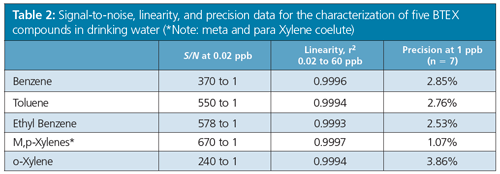
Comparing these data with Method 524.2 data from Table 1, it can be seen that the detection capability is in the order of 2–3 orders of magnitude lower, while the precision is significantly better.
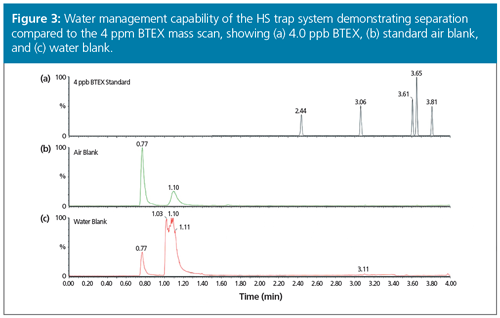
Conclusions
The analysis of BTEX compounds in drinking water samples by headspace trap coupled with GC–MS has been performed with enhanced detection capability and precision. With the analysis performed in less than 4 min, many samples can be analyzed in a day–helping to protect our drinking water supply. In addition, MS detection can provide further identification for unexpected interfering molecular species, thus limiting false positives for other analyte species. Water management in the system was handled with relative ease after purging for 2 min, and could be completely eliminated with an additional minute of dry purge time. Finally, with the recognized sample preparation benefits of headspace trap compared to purge and trap systems, greater uptime using this approach is offered. This solution can be very attractive for testing laboratories because it can mean operator ease of use, fast cycle times, longer intervals between system maintenance, together with method robustness and optimal analytical performance.
Acknowledgement
The author acknowledges and thanks Robert Thomas of Scientific Solutions for his contribution in writing this article.
References
1. EPA Method 524.2: The Measurement of Purgeable Organic Compounds in Water Using Capillary Column GC/MS: http://water.epa.gov/scitech/methods/cwa/bioindicators/upload/2007_11_27_methods_method_524_2.pdf
2. D.H. Kampbell and S.A. Vandegrift, Journal of Chromatographic Science36, 253–256 (1998).
3. Lee Marotta, PerkinElmer Application Note: http://www.perkinelmer.com/CMSResources/Images/44131604APP_HeadSpaceTrapGCMSLowBenzine.pdf
4. Lee Marotta and Dennis Yates, PerkinElmer Application Note: http://www.perkinelmer.com/CMSResources/Images/44131604APP_HeadSpaceTrapGCMSLowBenzine.pdf
5. Andrew Tippler, PerkinElmer Application Note: http://www.perkinelmer.com/pdfs/downloads/APP_011349_01_AromaCharacterizationofHops.pdf
Lee Marotta is a GC and GC–MS Senior Application Scientist at PerkinElmer Inc., in Shelton, Connecticut, USA.
E-mail:lee.marotta@perkinelmer.comWebsite:www.perkinelmer.com

New Method Explored for the Detection of CECs in Crops Irrigated with Contaminated Water
April 30th 2025This new study presents a validated QuEChERS–LC-MS/MS method for detecting eight persistent, mobile, and toxic substances in escarole, tomatoes, and tomato leaves irrigated with contaminated water.
University of Tasmania Researchers Explore Haloacetic Acid Determiniation in Water with capLC–MS
April 29th 2025Haloacetic acid detection has become important when analyzing drinking and swimming pool water. University of Tasmania researchers have begun applying capillary liquid chromatography as a means of detecting these substances.

.png&w=3840&q=75)

.png&w=3840&q=75)



.png&w=3840&q=75)



.png&w=3840&q=75)










